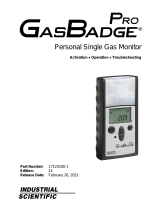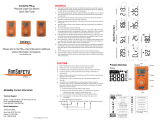
Ventis™ MX4 Product Manual
© 2018 Industrial Scientific Corporation 2
Contents
►Copyright Notice ........................................................................................................................................ 4
►Warnings and Cautionary Statements ....................................................................................................... 4
General ...................................................................................................................................................... 4
Personnel .................................................................................................................................................. 4
Hazardous Conditions, Poisons, and Contaminants ................................................................................ 4
General Usage .......................................................................................................................................... 5
Agency-issued Conditions of Use and Warnings ...................................................................................... 5
Recommended Practices .......................................................................................................................... 6
►Ventis MX4 Resources .............................................................................................................................. 6
►Ventis MX4 Capabilities ............................................................................................................................. 7
►Unpacking the Monitor ............................................................................................................................... 7
Contents .................................................................................................................................................... 7
Hardware Features and Functions ............................................................................................................ 8
Display Screen .......................................................................................................................................... 9
Alarms ..................................................................................................................................................... 11
►Monitor Set-up ......................................................................................................................................... 14
Batteries .................................................................................................................................................. 15
Docking Stations, Chargers, and other Accessories .............................................................................. 15
Battery Charging ..................................................................................................................................... 16
Power-on and -off .................................................................................................................................... 16
Configuration ........................................................................................................................................... 18
Instructions .............................................................................................................................................. 19
►Monitor Use and Service ......................................................................................................................... 27
Zero, Calibration, and, Bump testing ...................................................................................................... 27
Procedures .............................................................................................................................................. 27
Recommendations .................................................................................................................................. 27
General information ................................................................................................................................. 28
Instructions .............................................................................................................................................. 28
Supplies................................................................................................................................................... 29
Remote Sampling .................................................................................................................................... 35
Cleaning .................................................................................................................................................. 36
Service .................................................................................................................................................... 36
Aspirated Monitor .................................................................................................................................... 37






























